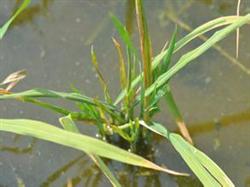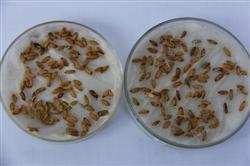Rotten Rice seedlings and its Preventive Countermeasures

Rotten rice seedlings are the general name of rotten seeds, rotten buds and dead seedlings that occur in the seedling stage. Rotten rice seedlings can be divided into two types: physiology and infectivity. Physiological rotten seedlings are mainly caused by low temperature and poor management measures; infectious rotten seedlings are caused by bacterial infection, and the main diseases are rice cotton rot, rice rot and rice blight. According to the different symptoms, infectious rotten seedlings can be divided into Ralstonia solanacearum type and yellow wilt type. In the dead seedlings of the wilt type, the heart leaves suddenly wilted and rolled into a tube, and then the lower leaves quickly lost water and wilted the drum, until the whole plant was dirty green and withered, and the roots of the diseased plants were dark, with few root hairs; the dead seedlings of the yellow wilt type, starting from the lower leaves, gradually yellowed from the leaf tip to the leaf base, and spread to the upper leaves to the heart leaves: finally, the base of the plant turned brown and softened until the whole plant was yellowish brown and withered. The root system of the diseased plant is dark, the root hair becomes sparse, and the root is easy to pull up. The prevention and control measures are as follows: 1. Sowing at the right time. Rice sowing requires that the daily average temperature is stable above 12 °C, lower than 12 °C or low temperature lasting more than 4 days is prone to rot. Within the above-mentioned temperature index range, all localities should pay attention to the local weather forecast, grasp the cold tail and warm head, seize the sunny day to sow seeds, do a good job of covering after sowing, or adopt other measures of heat preservation and cold protection, so that as long as there are five sunny days after sowing, and after the young roots are planted, it will not be easy to suffer the cold wave.' 2. Raising seedlings in greenhouse and thin film. Two-stage seedling raising in greenhouse is an important technical reform in rice production. To avoid rotten seedlings, the rate of mature seedlings is generally 10% higher than that of raising seedlings in the open field. 3. Select and reorganize the seedling field. Seedling fields should be arranged in fields with medium fertility, shelter from the wind and the sun, slightly higher terrain, sufficient sunshine and easy drainage and irrigation. After ploughing, fine soil preparation should be paid special attention to leveling the surface of the box to avoid stagnant water and rotten seedlings. 4. Rational fertilization. The principle of fertilization is based on sufficient fertilizer, topdressing should be repeated, first light and then thick. Human feces and urine should be fermented and ripened first, and the proportion of phosphorus and potassium fertilizer should be increased. Do not flood and fertilize the weak seedlings, you can first apply an appropriate amount of light dung water, wait for the seedlings to grow normally, and then chase more fertilizer when you begin to tiller. 15mur20 kg of plant ash can be applied to every 667 square meters of seedling field, which not only increases the potassium fertilizer, but also increases the soil temperature, makes the seedling grow healthily and enhances the disease resistance. 5. Scientific use of water. The main purpose of the bud stage is to take root and stand seedlings, keep the surface of the box moist and not flooded, and should not go to water too early to ensure the need for oxygen and prevent the sheath from growing too long. When a cold wave comes, deep water is poured into the water. Second, the three-leaf period is sunny, and the water layer is not flooded accordingly. The shallow water layer will be established after the third leaf, and the water will be drained after a long time of rain and initial sunshine. 6. Chemical control. If infectious rotten seedlings are found, fungicides should be used mainly. The seeds can be soaked in 1% lime water for disinfection; when making seedling beds, 70% dimethazone powder is mixed in the river mud, 1.25kg per 667m2 to control the blight; before sowing, rice is sprayed with a 50% emulsifiable concentrate of 700ltel 800 times to prevent early seedling death, and the seedling preservation rate can reach 90% Rh99%; if lamb disease occurs at the seedling stage, clean water or shallow irrigation can be replaced or drained and dried, and 60kg cupric sulfate 1000 times solution can be sprayed every 667m2 You can also put 0.1mur0.2 kg of copper sulfate per 667 square meters at the inlet to make it flow into the seedling field with the gradual melting of the water. If the standing blight occurs in the wet or dry seedling field, it can be irrigated and rescued every morning and evening. Spraying 1000 times of the raw powder of 70% dimethazone in one heart and one leaf stage can stop the expansion of dead seedlings.
- Prev

Symptoms of Fertilizer deficiency and excessive nutrients in Rice
First, the occurrence situation of rice black-streaked dwarf disease was first found in late rice in Guangdong Province in 2001. In recent years, the area of rice in Vietnam and southern China has expanded rapidly, with 9 provinces such as Guangxi, Guangdong and Hunan in 2009, with an area of 5 million mu, which is expected to exceed 10 million mu in 2010.
- Next

Breeding techniques for blast resistance of rice
The main diseases transmitted by rice seeds are evil seedling disease, rice blast, rice false smut, bacterial leaf blight, stripe blight transmitted by gray planthopper at seedling stage and so on. At present, it is the time for rice seed soaking in Qilin District. When soaking rice seeds, demonstration households must insist on soaking rice seeds with chemicals. The main purpose is to kill the germs carried by rice seeds.
Related
- The first cup of black tea in spring, the flavor and history of tea gardens in Kenya, Africa
- The computer can not only choose potatoes, but also grow tea rice. AI will grow winter oolong tea champion.
- It is not only the inflated tea bitten by insects, but also engraved with the four seasons tea in Beipu.
- The Oriental Beauty Tea Festival in Zhuxian County takes the stage at the weekend to experience the plus-size feast of oil tea.
- & quot; Oriental Beauty Tea & Exploration of Emei in Hsinchu, the hometown of quot;
- The new variety of strawberry "Tainong 1" dessert is the first choice with mellow aroma. Crimson gorgeous
- History of Tea in Taiwan: from Wild Inner Mountain to Export Tea Garden
- Two types of Taiwan Oriental Beauty Black Tea won the British three-Star Award for Childhood Tea Xiang Zhang Jiaqi changed from pilot to champion tea maker.
- Banana species and varieties: the planting history of Taiwan Xianren banana and dwarf banana is long, is banana disease resistant?
- Coffee planting Technology: Qianjie Coffee from Seedling to harvesting

